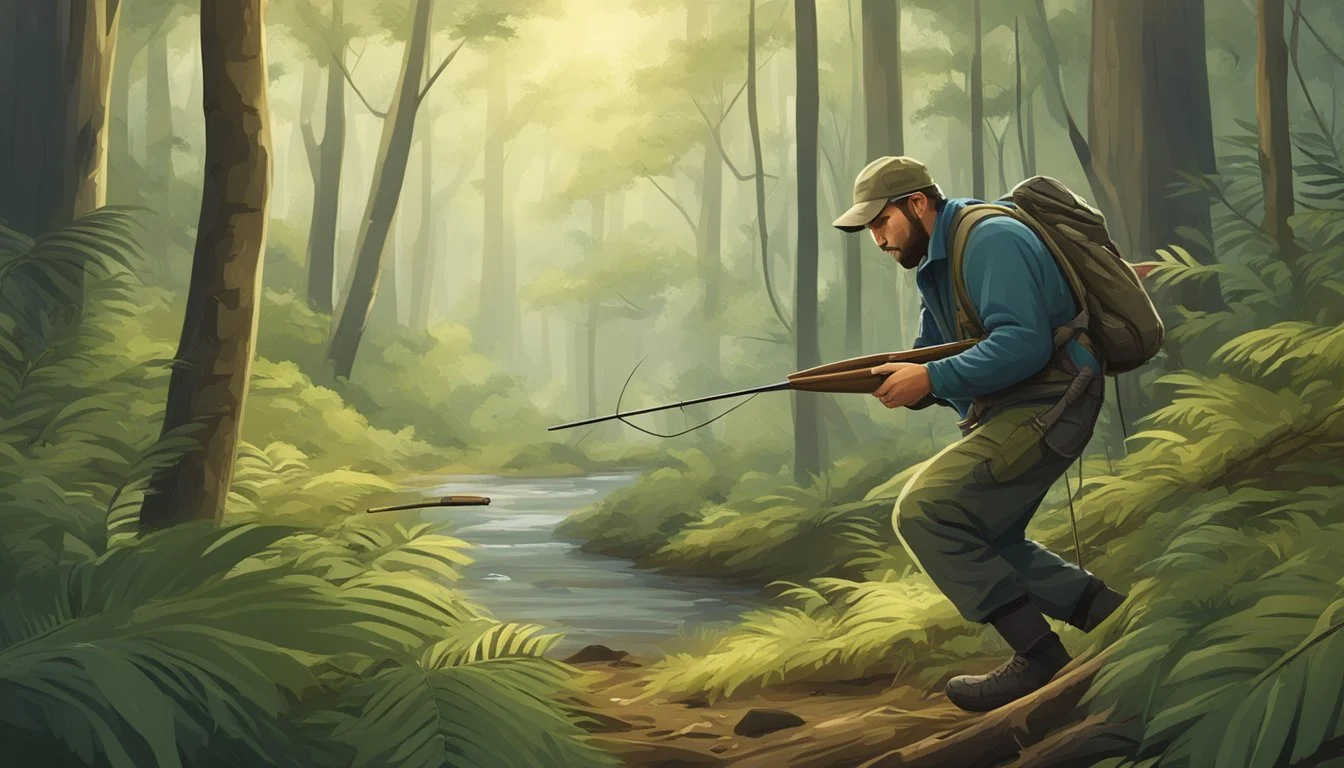Fisher Hunting for Beginners
Essential Tips and Techniques
The fisher, scientifically known as Pekania pennanti, is a unique member of the mustelid family, akin to weasels, minks, and martens. These medium-sized mammals are well-adapted to forested environments throughout North America, from the northern mixed forests to mountainous regions. Hunting fishers requires an understanding of their habitats, behaviors, and ecology. Being skilled climbers and agile hunters, fishers pursue a variety of prey, from snowshoe hares and squirrels to mice, making the knowledge of these prey species' habits useful for tracking fishers.
In becoming proficient at hunting fishers, one must recognize the importance of forested ecosystems to these creatures. They require large tracts of woods to thrive, with mature trees providing the necessary cover and denning opportunities. Fishers are solitary, predominantly nocturnal hunters, which adds a layer of challenge to ethical hunting practices. Regulations and seasons for hunting fishers vary by region, so it's crucial for beginners to familiarize themselves with the local wildlife laws to ensure a responsible approach to wildlife management and conservation.
A successful hunter is patient, observant, and respectful of the fisher's role in the ecosystem. Learning the physical characteristics of the fisher can aid in identification; they typically possess dark brown fur with lighter shading around the head, neck, and shoulders, and males are larger than females. Utilizing knowledge about the fisher's diet and foraging behavior can greatly enhance a hunter's chances of locating these elusive animals. Careful preparation, understanding fisher behavior, and habitat preservation are key fundamentals that support sustainable hunting practices for beginners interested in pursuing Pekania pennanti.
History and Taxonomy
Fishers, part of the genus Pekania, are forest-dwelling mustelids with a rich evolutionary history.
Species Overview
The fisher, Pekania pennanti, is a medium-sized mammal that resides in North American forests and is a member of the family Mustelidae, often referred to as the weasel family. This family also includes animals like weasels, mink, martens, and otters. The fishers are closely related to the genus Martes, and for a long time, were classified within that same group, highlighting their shared characteristics and ancestry.
Fishers are known for their elongated bodies, short legs, and bushy tails. Their fur ranges in color from light brown to black and may feature distinctive white patches on their chest. Historically, fishers were subjected to heavy trapping pressure due to the value of their fur, which has a rich texture and has been popular in the fur trade.
From a historical standpoint, the earliest known fossil of a member of Pekania dates back about 7 million years. The genus Pekania itself is endemic to North America, but there is evidence suggesting that similar species might have existed in Asia somewhere between 2.5 and 5 million years ago, indicating a more diverse historical distribution.
Physical Characteristics
The fisher, known as Pekania pennanti, is distinguished by a set of physical traits adapted for efficiency in hunting. This section details the size, appearance, and specific hunting adaptations of the fisher's physical makeup.
Size and Appearance
Fishers exhibit sexual dimorphism, where males are larger than females. Males typically measure up to 120 centimeters in length and weigh between 3.5 to 6 kilograms, while females are smaller, measuring up to 75 centimeters and weighing between 2 to 2.5 kilograms. The species sports a bushy tail, which adds to their length and is crucial for balance. Their fur, which is dense and well-insulated, can range in color from a lighter rusty brown to almost black, depending on the season.
Males: Length up to 120cm, Weight 3.5-6kg
Females: Length up to 75cm, Weight 2-2.5kg
Tail: Long and bushy
Fur: Seasonal color, from rusty brown to black
Adaptations for Hunting
Fishers possess several physical adaptations that make them effective hunters. Their claws are strong, sharp, and retractable, allowing them to climb trees with ease and capture arboreal prey. The animal's compact legs and agile body facilitate swift movement both on the ground and in the canopy. Fishers also have small, rounded ears that are sensitive to the sounds of prey, making them adept at detecting animals concealed under the forest detritus.
Claws: Strong, sharp, retractable
Ears: Small, rounded, acutely sensitive
Body: Agile, facilitating swift ground and aerial movement
Habitat and Range
Before hunting for fishers, it's crucial to understand where they live and roam. Knowledge of a fisher's habitat and range is fundamental for any beginner intending to track these elusive creatures.
Geographical Distribution
Fishers are indigenous to North America. Their range extends across Canada, into the northern United States, including the Northeast, the Great Lakes region, and into the Pacific Northwest. Here is a concise depiction of their distribution:
Canada: Extensive presence throughout most boreal forest regions.
United States: Primarily found in areas such as:
Northeastern states
Northern Rocky Mountains
Pacific Northwest, including northern California, Oregon, and Washington State.
Recent reintroduction efforts, including in the state of Tennessee, have aimed to expand their historical range.
Habitat Preferences
Fishers favor densely wooded areas which provide ample cover and opportunities for finding food. They thrive in large, contiguous forested landscapes that are primarily coniferous, although they can also be found in mixed-hardwood and conifer forests. Key habitat characteristics include:
Coniferous Forests: Essential for providing cover and denning sites.
Boreal Forests: Commonly found in this band of forest across Canada.
Pacific Northwest: Known for lush, dense canopy where fishers reside.
Urban Areas: Typically avoid urban environments but may be found in suburban woodlots.
Their preferred habitats not only offer protection from predators but also contain various prey species, facilitating their role as effective hunters in the ecosystem.
Diet and Hunting Techniques
Understanding the diet and hunting techniques of the fisher (Pekania pennanti) is crucial for beginners who are interested in learning about the species' behavior in the wild. This section will explore the types of prey the fisher hunts and the strategies it employs to catch them.
Prey and Predation
The fisher’s diet is quite carnivorous, focusing predominantly on small animals such as rodents, squirrels, and the snowshoe hare. Despite their name, fishers do not typically hunt fish (What wine goes well with fish?); instead, they are versatile hunters capable of adapting their diet to the available resources within their habitat. Porcupines are also a notable part of their diet, even though they are a challenging prey due to their quills.
Beyond live prey, fishers are known to incorporate other food sources like mushrooms, fruits, and carrion, especially when typical prey is scarce. This adaptability in their diet helps them to thrive in a variety of woodland environments.
Hunting Strategies
Fishers employ several effective hunting strategies that leverage their physical traits and adaptability. They are agile and proficient climbers, allowing them to pursue prey such as squirrels across trees. On the ground, they utilize their keen sense of smell to locate prey. Stealth and speed are key components of their hunting technique, as they can quickly dart through thick underbrush to capture unsuspecting animals.
When hunting porcupines, fishers use a specialized hunting strategy. They strategically attack the face of the porcupine to avoid its defensive quills. Their persistent and methodical approach in such scenarios showcases their adaptability and intelligence as predators.
Reproduction and Lifecycle
Understanding the reproduction and lifecycle of the fisher (Pekania pennanti) is crucial for wildlife enthusiasts and beginners in hunting. These medium-sized mammals have a distinctive breeding pattern and their young go through a significant development phase before reaching maturity.
Breeding Habits
Fishers generally mate once a year with the breeding season taking place in late March through early April. Post mating, embryonic implantation is delayed until the following spring, a process known as embryonic diapause. The proportion of adult females that reproduce annually is, on average, about 71%.
A characteristic table of Fisher's breeding habits:
Breeding Season Mating Implantation Late March - April Annual Delayed
Growth and Development
After a gestation period of around 50 days post-implantation, females give birth to litters averaging 2.5 kits. These litters can range from one to four kits. At birth, kits are blind and helpless, requiring several weeks of maternal care. Juvenile fishers undergo a growth period where they develop necessary survival skills before independence. Typically, young fishers are weaned after about 8 to 10 weeks, becoming fully mature at 1 year of age for females and 2 years for males.
Behavior and Social Structure
The fisher, known scientifically as Pekania pennanti, exhibits complex behaviors indicative of a solitary and territorial mammal. Understanding their territoriality and social interactions, including common predators, is crucial for beginners who wish to study or hunt this species.
Territoriality
Fishers maintain specific home ranges that they defend against other members of their species. Adult males generally occupy large territories that may overlap with those of several females, but are often vigilant against encroachments by other males. The size of these home ranges can vary significantly depending on the abundance of prey and the density of the fisher population in the area.
Interactions and Predators
As solitary animals, fishers engage in social behavior mainly during the mating season. Outside of mating, their vocalizations, such as high-pitched chirps and low growls, are primarily used for communicating over distances and may resemble mating calls or territory marking.
Fishers face predation threats from larger carnivores such as bobcats, coyotes, and larger mustelids like wolverines and martens. These predators may compete for the same resources or pose direct threats. Lynx, sharing similar habitats, are also potential competitors, but they usually do not engage directly due to the fisher's arboreal proficiency and aggressive defense tactics.
Conservation and Management
In the realm of fisher conservation, the focal points revolve around understanding current population trends and engaging in strategic efforts to protect and rebuild their habitats. Here's a look at the fishers' status and conservation initiatives ensuring their future.
Population Status
Fishers (Pekania pennanti) are no longer classified as endangered in most parts of their range in North America, signaling a successful rebound from previous population declines. Despite this progress, localized populations may still face challenges due to factors like habitat loss and climate change. Effective management strategies are critical in areas where they remain rare or have been reintroduced after being extirpated.
Conservation Efforts
Conservation efforts for the fisher include strict regulations on hunting and trapping, ensuring a sustainable approach to their population management. Additionally, measures to increase forest cover in eastern North America are paramount to bolstering the health of existing fisher populations. The active involvement of wildlife departments, such as the Washington Department of Fish & Wildlife, encourages public participation in monitoring, which in turn heightens the efficacy of conservation and management strategies. The reintroduction of fishers to suitable habitats is another critical component, fostering the expansion of the species into regions where they once roamed freely.
Hunting and Trapping Regulations
When engaging in the hunting or trapping of the fisher, it is essential that enthusiasts adhere strictly to state regulations and practice ethical hunting to ensure sustainability and respect for wildlife.
Legal Aspects
The fisher, Pekania pennanti, is subject to regulated trapping seasons to maintain population management. For instance, in Rhode Island, the designated trapping season spans from December 1 to December 24. During this period, trappers must comply with specific bag limits, such as a season bag limit of two fisher per person. Additionally, all trapped fishers must be tagged in alignment with the requirements set forth by the Department of Environmental Management (DEM).
Compliance with local laws is mandatory, and each state has distinct regulations that govern the trapping seasons, bag limits, and tagging requirements. Trappers must obtain the relevant permits and familiarize themselves with the local regulations before participating in trapping activities.
Ethical Hunting Practices
While legal compliance is imperative, ethical hunting practices go beyond mere adherence to laws. Ethical hunters respect the following principles:
Sustainability: Ensuring that their activities do not negatively impact fisher populations.
Humaneness: Utilizing trapping methods that minimize suffering to the animals.
Fair Chase: Engaging in hunting practices that do not give the hunter an unfair advantage over the fisher.
Trapping techniques should be chosen not only for their effectiveness but also for their humaneness. Trappers are encouraged to educate themselves continuously on the most current and humane trapping methods available.
Beginner's Guide to Hunting Fisher
When preparing to hunt Fisher, one should prioritize understanding their behavior, habitat preferences, and the legal regulations surrounding their harvest. Adequate preparation and mastery of effective techniques are crucial for a successful hunt.
Equipment and Preparation
Before heading out, hunters must ensure they have the right equipment. Essential gear includes:
Traps: Use live traps designed to capture Fisher humanely. Snares and leg-hold traps are also commonly used, but make sure they conform to local wildlife regulations.
Bait: Fishers are carnivorous mammals, so bait your traps with fresh meat or fish.
Protective Clothing: Wear layers to navigate the forest terrain and protect against the elements.
Climbing Gear: Since Fishers can climb, sometimes trapping requires setting up in trees.
Compliance with state and federal legislation is mandatory, so verify all trapping regulations and obtain necessary permits.
Techniques and Tips
To effectively hunt Fisher:
Locate: Look for signs of Fisher presence on the forest floor such as tracks, scat, or partially eaten prey. Fishers predominately dwell in forested areas and are adept climbers.
Set Traps:
Place traps near logs or tree bases, as these areas are frequented by Fishers.
Conceal traps with natural foliage to avoid detection.
Use Lures: Enhance the trap's effectiveness with scent lures that imitate the smell of a Fisher's typical prey.
Check Traps Regularly: Ethical trapping practice requires checking traps frequently to ensure any trapped animal is dealt with promptly and humanely.
Predator Awareness: Fishers are predators. Minimize your scent and noise to avoid scaring them off.
Stay patient and persistent. Fisher trapping can be challenging due to their retractable claws and agility, but with the right approach, success is attainable. Remember, safety and respect for the animal and environment should always guide a hunter's actions.








